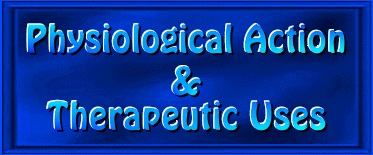

The following is excerpted from The Professional's Herbal Formula Handbook No. 2, comprising 82 pages of traditional information and recent scientific data that describes the medical properties, physiological action and therapeutic uses for each of the 24 ingredients outlined in this formula.




Adaptogenic, alterative, amphoteric, anabolic, analgesic, mild anodyne, antibiotic, anti-cachexic, anti-dyscratic, anti-hypoxic, anti-infective, antineoplastic (anti-tumor), antioxidant, antiphlogistic (anti-inflammatory), antipyretic, antiseptic, antispasmodic, bacteriostatic (anti-bacterial), calmative, choleretic, cholagogue, cytophylactic, cytotoxic, febrifuge, microbicidal (anti-microbial), nervine, neurotropic, relaxant, restorative, sedative, stimulant (circulatory and secretolytic), tonic and viricidal (anti-viral).


Alleviates any general fluids dyscrasia (abnormal or pathological condition) within the blood vessels, tissue-systems and mucous membranes throughout the entire organism during the onset of any immuno-depressant or immuno-suppressant conditions, and eliminates any form of cachexia (state of malnourishment and general debility) within the blood vessels, tissue-systems or mucous membranes throughout the entire organism in order to provide increased protection against any nutritional deficiencies or insufficiency that leads to various forms of immuno-depression or immuno-suppression; eases any tension or anxiety towards the various bodily symptoms and certain psychological or behavioral conditions associated with the initial knowledge or awareness of an AIDS condition in the body, and displays sedative effects upon the higher nerve centers in those conditions characterized by excessive nervous strain or restlessness; reduces any stress or nervousness throughout the body by utilizing the alkaloid valerine, valerianic acid, isovalerianic acid, and the sedative iridoid compounds (valepotriates), thereby calming and relaxing the nerves while balancing the central nervous system; possesses iridoid valepotriate (valeriana-epoxy-triester) compounds, which exert powerful tranquilizing effects upon the central nervous system by attaching themselves to individual receptor sites within certain portions of the brain, spinal column and nervous system in order to more effectively remove any tension or stressful conditions associated with shock or trauma, and provides predominantly equalizing or regulatory (amphoteric) activity upon the autonomic nervous system (due to the presence of valepotriates); promotes gentle and soothing effects upon the central nervous system (especially the cerebro-spinal centers), and exhibits pronounced neurotropic activity; displays sedative and nervine stimulant effects in order to relieve and soothe any nerve pain or irritation in the cerebro-spinal nervous system by reducing the reflex excitability of the nerves and nerve-centers, and displays nervine and calmative properties in those conditions characterized by atonic or functional nervous disorders by providing greater balanced energy for the proper regulation and tonification of the entire nervous system; penetrates directly into the locomotor tissues throughout the musculature and central nervous system, thereby providing a more subtle form of numbness to both regions in order to relieve any aches or painful conditions; exhibits sedative and antispasmodic activity upon both the smooth and visceral muscle tissues, due to the presence of valepotriates and the sesquiterpene constituents in the volatile oils (such as bornyl isovalerianate, bornyl acetate, bornyl formate, eugenyl isovalerate and isoeugenyl isovalerate); stimulates the nervous system in those conditions characterized by strumous enlargements of certain glandular structures, and acts as a stimulant in certain low feverish states that usually occur during the course of any acute febrile conditions; exhibits cytophylactic and cytotoxic properties in order to provide stronger cellular defense mechanisms against many physical or chemical agents and infectious conditions, including various brain, skin or intestinal infections; exhibits bacteriostatic, microbicidal and viricidal effects in order to strengthen and increase the resistance of the blood vessels against any invasive or harmful pathogenic bacteria or microbes, as well as to inhibit the further development of any inflammatory or infectious conditions associated with the onset of various auto-immune disorders; demonstrates significant bacteriostatic activity against Gram-positive bacteria (due to the presence of certain alkaloids), and displays potent cytotoxic effects against Krebs II ascitic tumors (due to the presence of valtrate and didrovaltrate); exhibits significant antiphlogistic activity in order to inhibit the formation of certain inflammatory compounds (such as histamine, leukotrienes, prostaglandin, serine proteases and thromboxanes), as well as to reduce any severe inflammatory swelling associated with any blood vessel or tissue inflammation and various other internal inflammatory conditions; exhibits significant antiseptic activity by destroying the vitality of any organized living ferments in order to prevent the onset of putrefaction or septicemia, and precipitates the proteins in any inflamed tissues in order to provide a mildly antiseptic and protective coating (under which the regeneration of new tissue occurs) for the mucous membranes throughout the entire organism; acts as an effective antiseptic in order to remove any septic conditions associated with tissue degeneration or ulceration, and promotes increased suppuration and a steady toning or restorative impression to the entire glandular system (especially the liver and lymph glands); exhibits anti-hypoxic properties in order to prevent the occurrence of any harmful oxygen deficiencies, and provides total non-interference with the essential REM (rapid eye movement) sleep-state phase that is essential for processing various emotional experiences by the mind; exhibits anabolic activity in order to accelerate the production of DNA and RNA (which enhances the production of proteins in the form of antibodies), while increasing protein and lipid synthesis in the bone marrow and DNA/RNA content in the adrenals and lymph nodes (along with increased body weight and enhanced re-synthesis of glycogen and high-energy phosphate compounds); demonstrates powerful adaptogenic (balancing and strengthening) activity in order to increase the overall resistance of an organism towards any adverse influences or stressful conditions (whether they be physical, chemical or biological in nature), especially upon the immune system and both the central (cerebro-spinal centers) and peripheral nervous systems; acts as a secretolytic stimulant in order to promote increased gastric, pancreatic or intestinal secretory and motor activity, and enhances greater peripheral circulation (due to its antioxidant activity); exhibits significant antioxidant effects in order to provide greater oxygen-transport capabilities throughout the bloodstream, as well as enhance the transport of additional oxygen directly into the cells and tissue-systems throughout the entire organism; acts as a circulatory stimulant by increasing the blood flows through the arteries and blood vessels in order to enhance greater nutrient transport, absorption and utilization, thereby accelerating the healing processes associated with the repair of any damaged mucous membranes or tissue-systems; displays alterative activity in order to correct any disordered bodily function, thereby activating increased alterations in both metabolic and tissue functions as a defensive measure against the onset of acute or chronic disease; exhibits restorative effects in order to regain increased vigor or vitality and greater strength, while enhancing normal tissue and metabolic functional capabilities; demonstrates alterative and restorative properties in order to re-establish healthy systemic functional capabilities, as well as to establish greater vascular tone throughout the entire organism (due to its ability to stimulate increased secretory flows); exhibits alterative effects in order to stimulate the anabolic growth processes, thereby enhancing the repair of any degenerated, deteriorated or debilitated cells or tissues (while promoting the elimination of any catabolic waste materials); displays tonifying effects in order to permanently enhance the overall energy-levels throughout the entire organism, without adversely affecting the functional capabilities of any particular organ or system.
![]()
None.
![]()